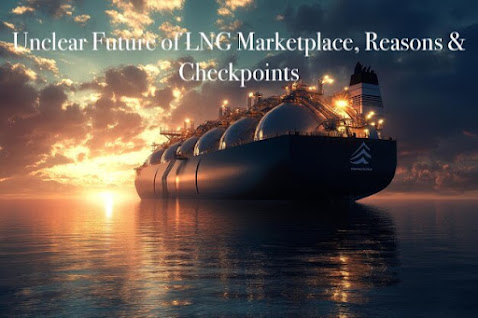Unclear Future of LNG Marketplace, Reasons & Checkpoints
The Global LNG Industry: Navigating Investment Challenges Amid Market Evolution
The global LNG industry has evolved rapidly over the past two decades, especially in recent years, taking center stage in the energy security policies of importing nations. Natural gas producers increasingly view LNG as a safer and more flexible option that allows them to reach a broader consumer base, extending beyond regional markets despite the added cost of liquefaction.
Simultaneously, importing countries have leveraged LNG to diversify supply risks by engaging with a wider base of producers. Today, LNG offers both producers and consumers a level of flexibility approaching that of the oil industry.
With over 100 nations worldwide committed to NetZero by 2050 and many of them have set their targets. One of these relatively easy target is to shift from Coal based or heavy hydrocarbon based power generation to the natural gas where LNG is available in the spot market. We also find a country like USA escalating its fracking investments to cater with the demand of NG in the local market and internationally.
Current Market Landscape
As of 2024, global LNG liquefaction capacity reached 494.4 million tonnes per annum (MTPA), with asset utilization rates ranging between 86% and 89%. Despite this high utilization, the market remains under-supplied, presenting a ripe opportunity for investors to inject capital into expanding processing capacity.
Numerous projects are currently in the pipeline, with many expected to come online between 2026 & 2030. These could help balance the mismatch between supply and demand. However, investor sentiment remains cautious due to perceived risks—particularly on the demand side. According to the IGU's World LNG Report 2025, as of the end of 2024, 1,121.9 MTPA of liquefaction capacity was in the pre-Final Investment Decision (pre-FID) stage. North America leads the proposed capacity, accounting for 648.4 MTPA—broken down into 366.9 MTPA in the U.S., 227.3 MTPA in Canada, and 54.2 MTPA in Mexico. Other significant contributors include Russia (170.4 MTPA), Africa (133.3 MTPA), Asia Pacific (67.0 MTPA), and the Middle East (66.5 MTPA), with the remainder (36.3 MTPA) scattered across other regions.
Barriers to Investment
Despite positive indicators such as technological advancements, market expansion, political support, and rising demand, a number of critical risks continue to delay or condition the approval of necessary investments. These include:
1. Project Execution Risks
Recent and ongoing LNG projects are experiencing delays and cost overruns, primarily due to surging commodity prices, labor shortages, and volatile geopolitical and trade conditions. For instance, Russia’s Arctic LNG projects have become emblematic of such challenges.
2. Trade Restrictions and Tariffs
Trade policy uncertainty—especially under administrations like that of Donald Trump, which has oscillated between imposing and lifting tariffs—adds a layer of unpredictability. This elevates the cost of risk mitigation and acts as a deterrent to investment.
3. Geopolitical Tensions and Transit Route Vulnerabilities
Strategic shipping lanes such as the Bab el-Mandeb Strait face potential threats to LNG carriers originating from the Middle East en route to Europe. Despite assurances from groups like the Houthis in Yemen, insurers and operators remain cautious. The 2021 Suez Canal blockage further highlighted these vulnerabilities. Additionally, persistent tensions between the U.S. and Iran raise concerns over the security of Middle Eastern LNG supply routes.
4. GHG and Methane Emissions Regulations
Methane, a potent greenhouse gas, is under increasing regulatory scrutiny. The EU’s methane regulation impacts both domestic production and imports, with non-compliance risking financial penalties. In the U.S., while the Biden administration implemented similar rules, they were rolled back under the Trump administration, introducing further regulatory uncertainty.
5. Economic Growth Uncertainty
Although many economies are scrambling to secure energy resources, some are beginning to consider re-exporting LNG volumes if domestic demand falls short. This reflects underlying concerns about the reliability of long-term growth forecasts, making it difficult for investors to justify large capital commitments based on uncertain demand projections.
6. NetZero & Demand in European Market
While NetZero committment by many nations helped the LNG producers in the short term with increased demand and increased prices, yet with the push for adotion of more renewable energy investments in the medium term and long term may cause weaker demand on fossil fuels including LNG. Signes of weaker demand in European markets already in place as we speak with UK & France reduced their LNG importing forecast in 2025 beyond.
Navigating the LNG Investment Maze
Clear directives from policymakers and global institutions are prompting further innovation in emissions reduction, carbon capture and storage (CCS), and the overall decarbonization of the LNG value chain. Such innovations will enhance investors apetite to proceed funding pending projects.
As tariff disputes begin to subside and peace negotiations in the Russia-Ukraine conflict appear on the horizon, some geopolitical risks may ease. This could lower the cost of risk mitigation and unlock future investment potential.
Emerging markets, particularly in Africa and Latin America, offer significant untapped reserves and growing energy demand. These regions may present attractive alternatives for investors seeking to diversify away from traditional supply centers.
Conclusion
The LNG industry stands with clear opportunity from growth prospective. While market fundamentals and global energy trends support further investment, substantial risks—ranging from regulatory and geopolitical challenges to execution and demand uncertainties—must be carefully navigated. Investors who can manage these complexities and adopt a long-term strategic view will be best positioned to capitalize on the opportunities presented by the evolving global LNG market.


Comments
Post a Comment